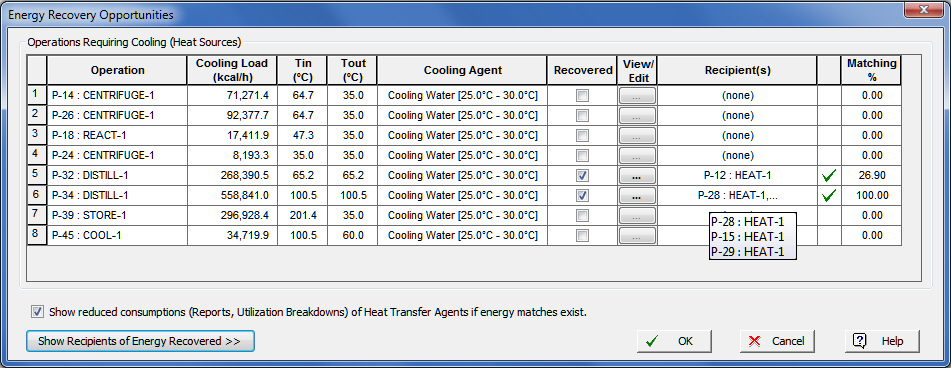Energy Recovery
Staring with version 9.0 of SuperPro Designer the user has the option to recover energy and thereby introducing savings to the annual operating cost. When appropriate, heat removed from operations that require cooling (e.g. a distillation’s condenser load) can be used as ‘donor’ to operations that require heating (e.g. a reaction feed heater). If currently the process is using a hot agent (e.g. “Steam”) to preheat the feed to the reactor and a cold agent (e.g. “Cooling Water”) to cool down the distillate in the column, integrating the two loads will yield savings in the consumption of both “Steam” and “Cooling Water”. Therefore, conserving energy will significantly reduce the overall utility usage and the associated utility costs as reflected in the annual operating cost (AOC). Energy recovery can materialize in two ways:
a) by matching heat source locations (operations that currently require cooling) with one or more locations (operations) that currently needing heat, or
b) by matching heat source locations (operations that currently require cooling) with appropriate heating agents that can be regenerated using that load as heating load.
It is important to recognize that integrating a heating load with a cooling load, in reality, will require to actually bringing the corresponding material together into a heat exchanging unit. This is not always an option to be represented on a SuperPro flowsheet, since for some of the loads required by an operation the actual material line is not available. Consider, for example, the condenser load in a distillation column. Even if one wanted, he/she could not physically draw a stream out of the column and integrate it with the feed of a reactor (that, let’s say, requires heating). But even in cases where this may be possible user may still not find this as an attractive proposition. Consider a cool-down of material in one part of process (accomplished with an cooler now and a cooling agent) and a pre-heat of material in another part of the process (using a heater and ‘Steam’ currently). Bringing the two lines together may create an inordinate amount of line drawing in the process and create more iterative calculations for the M&E balance calculations. The Energy Recovery Opportunities Dialog allows users to introduce such heat integrations and realize the cost savings implied but without unnecessarily complicating the process flowsheet..
|

|
Users must understand that the representation of heat recovery/integration in SuperPro Designer is a very simplistic approach in materializing savings in utility consumption. For starters, the actual (extra) equipment necessary to effectuate the heat transfer is unaccounted. Also, just because the heating/cooling loads may match, and the temperatures of the heat ‘donor’ is compatible with the temperatures of the material being heated up, it doesn’t necessarily mean that such an integration is actually realizable perhaps due to topological or safety restrictions, or due to other undesirable effects introduced to the process from such integration (e.g. reduced stability and robustness in the face of operating condition changes, increased costs for startup and shat down procedures), etc.
|
The energy recovery matches can be proposed through the Energy Recovery Opportunities Dialog. This dialog can be shown by:
● Selecting from the main menu of the application, or
● Selecting .from the flowsheet’s context (right-click) menu.
The the interface that appears is shown in Energy Recovery Opportunities Dialog The user may will be presented with a list of all the operations (locations) currently requiring cooling in the process. These locations are the potential heat sources (or heat ‘donors’) which can be matched with suitable operations requiring heat (i.e. needing to be heated up) or suitable heating agents whose regeneration temperature increase may be appropriate..
Energy Recovery Opportunities Dialog
Economic Figures Affected by Heat Recovery
Finding matches between operations that require cooling (heat ‘donors’) and operations that require cooling (heat ‘receivers’) we introduce a double elimination of utilities: the cooling utility used currently at the heat ‘donor’ operation and the heating utility currently by the heat ‘receiver’ operation. This reduced consumption of utilities will reflect itself as savings in the annual operating cost (see Savings). If, on the other hand, the user decides to use the recovered heat from the heat ‘donor’ to regenerate an appropriate heating agent, then, the equivalent amount of that agent will also be reduced thereby producing more savings. If that agent’s total consumption is less than what can be regenerated from the recovered heating load (or perhaps that agent is not even at all engaged currently in the process), the remaining load will be reflected as ‘credit’ (see Credits) using as credit price the credit price of the agent as provided by the user (see Heat Transfer Agent Properties).
In order to better understand the economic impact that heat recovery matches bring upon the net total annual operating cost in the form of savings see Net Annual Operating Cost. Any savings existing in the process can be seen on the Executive Summary Dialog and in the Profitability Analysis section of the Economic Evaluation Report (EER)
By default the consumptions of heat transfer agents associated with the process as well as in the reports, charts and utilization breakdown trees, are not affected by any heat recovery matches. Not unless the user explicitly specifies his desire to do so by checking the option ‘Show reduced consumptions (Reports, Utilization Breakdowns) of Heat Transfer Agents if energy matches exist’, on the Energy Recovery Opportunities Dialog or the option ‘Show reduced consumption of agents due to heat recovery’ on the Utility Selection For Consumption Chart dialog.
![]()
